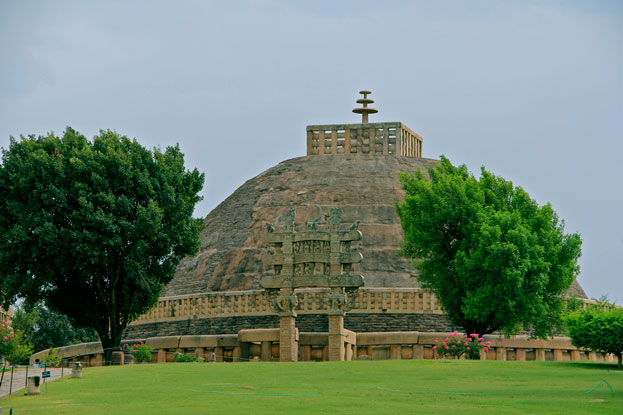On a hill overlooking the plain and about 40 km from Bhopal, the site of Sanchi comprises a group of Buddhist monuments (monolithic pillars, palaces, temples and monasteries) all in different states of conservation most of which date back to the 2nd and 1st centuries B.C. It is the oldest Buddhist sanctuary in existence and was a major Buddhist centre in India until the 12th century A.D. From the time that the oldest preserved monument on the site (Asoka's column with its projecting capital of lions inspired by Achaemenid art) was erected, Sanchi's role as intermediary for the spread of cultures and their peripheral arts throughout the Maurya Empire, and later in India of the Sunga, Shatavahana, Kushan and Gupta dynasties, was confirmed.
Continent: Asia
Country: India
Category: Cultural
Criterion: (I)(II) (III)(IV) (VI)
Date of Inscription: 1989
Oldest extant Buddhist Sanctuary
Sanchi is the oldest extant Buddhist sanctuary. Although Buddha never visited the site during any of his former lives or during his earthly existence, the religious nature of this shrine is obvious. The chamber of relics of Stupa 1 contained the remains of Shariputra, a disciple of Shakyamuni who died six months before his master; he is especially venerated by the occupants of the 'small vehicle' or Hinayana. Having remained a principal centre of Buddhism in medieval India following the spread of Hinduism, Sanchi bears unique witness as a major Buddhist sanctuary to the period from the 3rd century BC to the 1st century AD.
When it was discovered in 1818 by General Taylor, Sanchi had lain abandoned for 600 years. The site, 45 km from Bhopal, was overrun with vegetation. Excavations began in somewhat disorganized fashion until the Archaeological Survey of India stepped in and took control. Gradually, as the hill was cleared, the ruins of about 50 monuments were uncovered, revealing one of the most remarkable archaeological complexes in India.
 |
| Buddhist Sanctuary Sanchi |
Browse Gallery Plus UNESCO Storyline
It would appear that the site was settled in the 3rd century BC at the time that the Emperor Asoka, the grandson of Chandragupta, who had defeated the Macedonian invaders and founded the Maurya dynasty, was converted to Buddhism (c. 250 BC). Asoka, whose queen was from the neighbouring town of Vidisha, founded, or at least embellished, a Buddhist sanctuary located at Sanchi.
He also had a stone column more than 12 m high erected with his edicts carved on it. To the south of Asoka's column and predating it is an early brick stupa about 20 m in diameter and crowned with stone aedicula; a wooden railing encircles it. Now known as Stupa 1, this monument was enlarged under the Sunga and the Andhra dynasties (2nd and 1st centuries BC) and is the principal monument at Sanchi.
It consists of a gigantic mound of sandstone surrounded by sumptuous porticoes with stone railings; it's hemispherical dome measures 36.6 m in diameter and is 16.46 m high. It is particularly famous for the extraordinarily rich decorative work on the four monumental gateways (torana) that provide access. Positioned almost exactly in line with the four cardinal points, these gateways transpose into stone the structure of the wooden gateways: two pillars and three architraves reproduce the assembly of two posts joined by three rails.
The lush carvings, prodigious creations in bas relief, high relief and in the round, are an iconographic treasure trove. The essential theme represented in the decorative work revolves around the former lives of Buddha. Numerous other themes were taken from legends and history.
The fresh, wonderfully charming representations of plants, animals and humans, the narrative quality of the stories and the creativity apparent in the fantastic sculptured capitals and cornices combine to make this an unrivalled masterpiece of early Buddhist art. Sanchi has two other famous stupas dating from the Sunga period (2nd century BC). The torana of Stupa 3, executed in the 1st century, are exceptional works.
Many other structures are found on the site: within the ruins of a wall dating from the 11th-12th centuries, Sanchi's final years are represented by monolithic pillars, palaces, temples and monasteries, all in varying states of preservation. Temples 17 and 45 and monastery 51 are among the most impressive structures.
Browse All UNESCO World Heritage Sites in
India. The original UNESCO inscription
Here!!!




